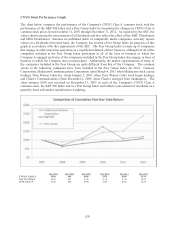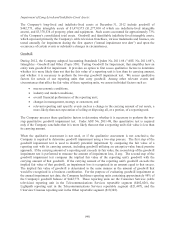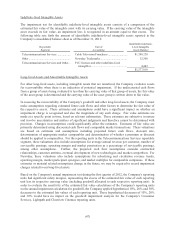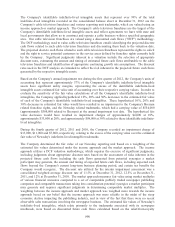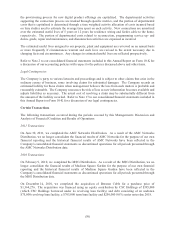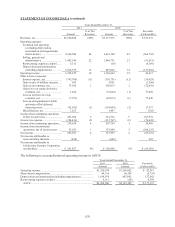Cablevision 2012 Annual Report Download - page 49
Download and view the complete annual report
Please find page 49 of the 2012 Cablevision annual report below. You can navigate through the pages in the report by either clicking on the pages listed below, or by using the keyword search tool below to find specific information within the annual report.
(43)
the cable distribution network in areas serviceable without further extending the transmission lines,
including our commercial data and voice customers). As penetration rates increase, the number of
available homes to which we can market our services generally decreases. We also derive revenues from
the sale of advertising time available on the programming carried on our cable television systems.
Programming costs are the most significant part of our operating expenses and are expected to continue to
increase primarily as a result of contractual rate increases and additional service offerings.
In 2012, in our New York metropolitan service area, we did not implement a residential rate increase and
extended the term of certain promotional offers as a result of our focus on retention and acquisition of
subscribers. Consequently, our revenue growth for the year ended December 31, 2012 was negatively
impacted. Additionally, we have experienced a significant increase in our level of capital expenditures
and an increase in our operating expenses for the year ended December 31, 2012 (excluding the
incremental costs attributable to Superstorm Sandy). We expect these capital expenditures and operating
costs to continue to be significant as we further enhance our service offerings. See "Liquidity and Capital
Resources - Capital Expenditures" for additional information regarding our capital expenditures.
See discussion below in "Business Segments Results - Telecommunications Services" for a summary of
service outage credits, incremental costs and capital expenditures related to Superstorm Sandy.
Our cable television service, which accounted for 52% of our consolidated revenues, net of inter-segment
eliminations, for the year ended December 31, 2012, faces competition from video service provided by
incumbent telephone companies, DBS service providers, and others, including the delivery of video
content over the Internet directly to subscribers. As discussed in greater detail below, we face intense
competition in our New York metropolitan service area from two incumbent telephone companies,
Verizon Communications, Inc. ("Verizon") and AT&T Inc. ("AT&T"), which offer video programming in
addition to their voice and high-speed Internet access services to residential customers in this service area.
Verizon has made and may continue to make promotional offers to customers in our New York
metropolitan service area at prices lower than ours. To the extent these incumbent telephone companies
continue to offer promotional packages at prices lower than ours, our ability to maintain or increase our
existing customers and revenue may continue to be negatively impacted. There are two major providers
of DBS service in the United States, DISH Network and DirecTV, each with significantly higher numbers
of subscribers than we have. We compete in our service areas with these DBS competitors by "bundling"
our service offerings with products that the DBS companies cannot efficiently provide at this time, such
as high-speed Internet access service, voice service and interactive services carried over the cable
distribution plant. Historically, we have made substantial investments in the development of new and
innovative programming options and other service offerings for our customers as a way of differentiating
ourselves from our competitors.
Verizon and AT&T offer video programming as well as voice and high-speed Internet access services to
residential customers in our New York metropolitan service area. Verizon has constructed fiber to the
home network plant that passes a significant number of households in our New York metropolitan service
area. Verizon does not publicly report the extent of their build-out or penetration by area. We estimate
that Verizon passes approximately half of the households in our New York metropolitan service area.
Verizon's passings in our service area are difficult to assess because they are based upon visual
inspections and other limited estimating techniques, and therefore our estimate serves only as an
approximation. Verizon has obtained authority to provide video service for a majority of these homes
passed, on a statewide basis in New Jersey, in numerous local franchises in New York State, including all
of New York City, and in a small portion of Connecticut. AT&T offers video service in competition with
us in most of our Connecticut service area. This competition impacts our video revenue in these areas
and may continue to do so in the future. Verizon and AT&T also market DBS services in our New York
metropolitan service area. Each of these companies has significantly greater financial resources than we
do.




